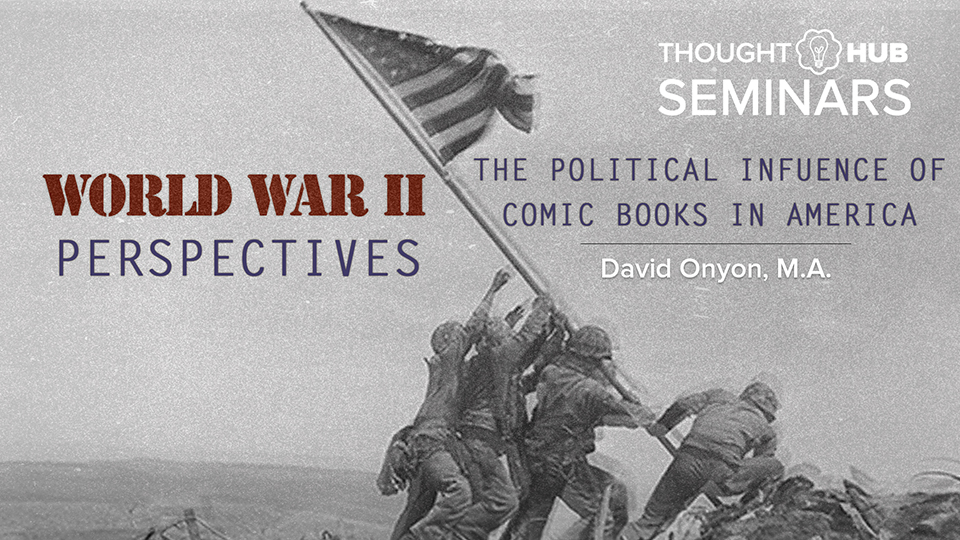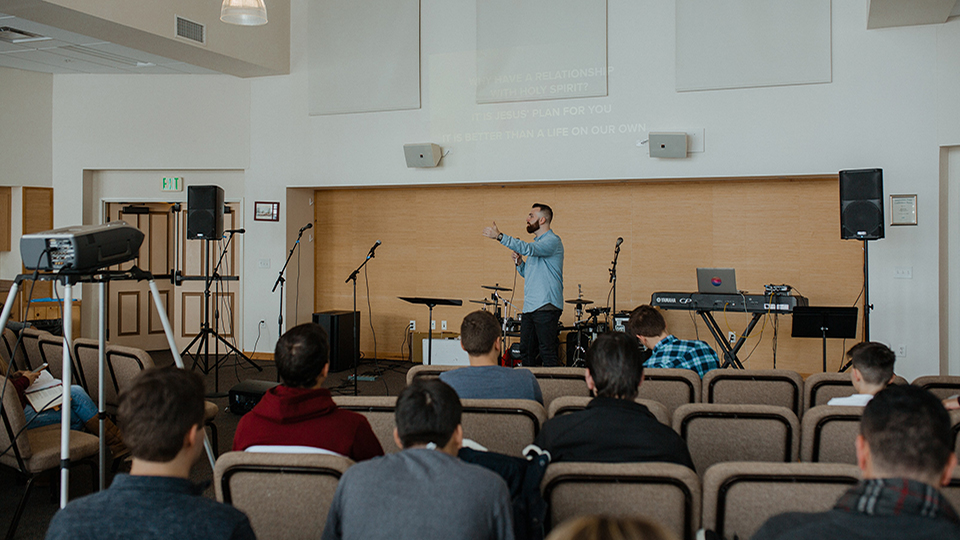
Did you know that comic books were used as propaganda during World War II? While adults were targeted through posters and short films that were shown before movies, American children were targeted through some of our most prominent superheroes to date such as Captain America, Superman, Batman and several others. These superheroes embodied the ideal virtues of American soldiers and demonstrated the courage and resolve needed to fight evil during World War II. In this vlog, David Onyon, SAGU History Professor, discusses how the effort to win WWII went hand-in-hand with comics.
TRANSCRIPT
– [MUSIC PLAYING] All right, welcome. Real quick disclaimer about some of the content today. These were illustrations and slogans that were written in the ’30s and ’40s. And so we’ll be discussing them as they were presented. They are very much just plainly racist, the way some of the other nationalities are drawn in caricatures. So I just wanted you to be aware of that before we start our presentation today. Sp let’s get to Comics at War. The isolationist stance taken by the United States during the early months of World War II was quickly dissolved after two years. After Pearl Harbor the principal concern became financing the war effort, which resulted in the US Treasury creating a defense bond program. To persuade Americans to purchase these bonds, propaganda was unleashed in many forms. Most adults would see this propaganda in the forms of posters and in short films before movies. But for children, comic books became the method of this communication. The comic books embodied the virtues of what it was to fight evil during World War II. In fact, the comic book still embodies the same virtues today. Back in 1977 author Michael Uslan stated the following about the nature of comic books. “From the 1930s through today comic books have expressed the trends, conventions, and concerns of American life. Comics have been a showcase for national views, slang, morals, customs, traditions, racial attitudes, fads, heroes of the day, and everything else that make up our lifestyles.” Comic books as we know them today arrived in the late 1930s. In June 1938 Action Comic Number 1 premiered and released and exposed Superman to the world, the character who encapsulated all that was good about America and humanity. And he became a star of the result of this issue. Other characters soon followed, including the Human Torch, Batman, the Sub-Mariner, Wonder Woman, Captain Marvel, The Shield, and of course Captain America. Superman became popular for many reasons. Like many Americans, Superman was an immigrant, albeit from an alien world. You could argue that Superman was the ultimate immigrant being away from his parents and his family. Secondly, Superman espoused the virtues of hard work, justice, and truth. Comic books also became popular for other virtues during the 1930s, which was experiencing the Great Depression. “Even as a form of escape,” Scott Cord claims, “the comic book allowed readers to fantasize about punishing real life wrongdoers. Since the depression was overtaking the concerns of Americans during the 1930s, readers enjoyed seeing superheroes fight against those who exploited the bad times for their own financial benefits. For example, early characters such as the Green Lantern, Superman, and Batman often took on corrupt businessmen who mistreated poor and desperate workers in the late 1930s.” The effort to win the war went hand-in-hand with the comics. The main focus of comics during that period was to sell war bonds. Most if not all comics used their superheroes to prove their patriotism during the war. Covers of comics during this time usually had graphics urging customers to invest in war bonds. Comic books went the extra mile when supporting the propaganda movement. Publishers often transformed superheroes to fit the ideal patriotic character. The covers of these comics always boasted lines supporting buying and selling of war bonds. The aim of this form of propaganda was directly related to these sales. The key to winning the war was for all Americans to pitch in and do their part. And the availability of war bonds was the way in which all could participate. In 1940 and 1941, many comic books had story lines about the events of the wars in Europe and Asia. These stances, of course, were before the United States entered the war and they were quite controversial. At a time when most Americans wanted nothing to do with another war in Europe, the characters in the comic books did. And many of the writers of the comic book heroes were actually Jewess and felt it was their duty to influence the American public of the dangers of what was taking place overseas. Early editions of Batman comics shed light on the fact that Batman never used guns or killed. But in this 1943 comic book, you can see Batman as he is supplying guns to American soldiers and supporting the seventh war loan. DC Comics also use Batman in the crusade to persuade Americans to purchase war bonds. One cover of a Batman comic, number 18 right here, shows Batman and his sidekick Robin blowing up a firecracker in the face of the Axis leaders. The cover reads, “Ensure the 4th of July. Buy war bonds and stamps.” Other comics include Batman as well as Superman. The cover of a DC winter issue, right here, depicts Superman, Batman, and Robin as selling war bonds at a newsstand. The sign above them reads, “Sink the Japanazis with war bonds and stamps.” Other publishers participated in this comic book propaganda, as well. Superheros such as the Green Hornet, the Spy Smasher, Captain Marvel, Catman, and the Black Terror were all used to fight against American enemies. The US government also joined in the creation of their own comic books. In 1943 the United States was in dire need of plane fuel. By this time workers stationed at oil refineries were becoming bogged down in their work. The government’s Petroleum Administration for War designed comic books to inspire the workers. The first comic, Coming on a Wing and a Prayer, was a huge success and forced the PAW to create the Undercover War comic book series. These comics proved to workers how important their job was. Captain America embodied the use of comic books as propaganda during the Second World War. His character was tailor made to support the overall war effort. A now famous superhero, he was created to sell war bonds. Put in creation in 1941 by Timely Comics, but later Marvel Comics, Captain America became the face of World War II comic propaganda. The main character, Steve Rogers, a frail young man, unfit for service is invited to participate in a secret program to become a super soldier. He participates and now he is the peak of human perfection and he aids the United States in the war effort. Captain America sports a costume with the American flag, carries a shield made out of vibranium from Wakanda and it is bullet proof and used as a weapon. Many covers of Captain America comics show the superhero going toe to toe with Nazi soldiers and even Hitler himself. This created widespread support of the war effort and Captain America comics. The covers of Captain America fighting against Hitler stirred US support and increased the war bond. Fighting for the United States at this time was viewed as the utmost heroic deed. Though a fiction story, the creation of Captain America brought forth the idea that all citizens were capable of supporting those abroad. The addition of Timely Comics’ Captain America was essential to the sale of comic books and war bonds. Captain America’s transformation was relatable to the American population. Citizens realized, as regular citizens they too could contribute to the war effort. The purchasing of war bonds was a way that all citizens could help and Captain America was essential to that. This cover right here was published a full nine months before the United States entered the war. And you see captain America punching Hitler in the face. The writers, Joe Simon and Jack Kirby, received hate mail for this cover and expressed concern about the goals of Captain America. They were opposed to such story lines. Captain America stood out in his patriotic red, white, and blue uniform and the ideals of American nationalism. Within a year Pearl Harbor had occurred. And Captain America’s views about evil became the norm. When the war began 15 million comic books were being published a month. Two years later 25 million copies were sold a month. Superman and Captain America each sold a million editions a month. And the largest single customer in the United States was the United States Army. The army originally brought comics as a diversion. But soon many of the soldiers became hooked on the story lines, character development, and the virtuous fight against evil and oppression. Throughout the war, comic book superheroes were involved in doing things to help the war effort beyond just fighting. They did things like deliver supplies, stop spies at home, and do whatever they could do to help the soldiers in the war. The depiction of the character’s actions were simplistic and good always triumphed over evil. The characters are always illustrated warrings and how children could help win the war. Superman was also transformed into a patriotic hero willing to do anything to defend his country. Superman appeared in numerous DC Comics over the span of World War II. The cover of a Superman comic, number 58, reads, “Superman says you can slap a Jap with war bonds and stamps.” Another comic throws its support behind the seventh war loan. And it reads, “And it isn’t Superman who’s doing this. It’s the American people.” However, Superman never fought the war. You would think that he could have ended the war by himself. And the authors of Superman were aware of this and did not want that. So instead they created this comic book story right here where Clark Kent so anxious to pass his physical uses his X-ray vision and reads the eye chart in the neighboring room. And he flunks his physical, is declared 4-F, and is forced to do what he can along the home front. Captain America was the major exception. With his sidekick, 12-year-old Bucky Barnes, they took a firsthand role in fighting the forces of evil. What made Captain America comics different for the time period was they were violent, in fact, shockingly violent for the time period. Characters were shot between the eyes, left beaten and bloodied, and tortured. Another aspect of Captain America that endeared him to many Americans was he always fought by the rules and his antagonists always cheated and lost. Soon other comics followed. Individual stories of bravery and courage ended with the American soldier overcoming fear and saving the day. Meant at first to inspire those at home, the characters would also inspire those actually doing the fighting. Many of the writers of these comic books were part of the Office of War information. And these organizations were supposedly interested in giving accurate information about what was happening overseas. Even the advertisements in the comic books were war related. In addition to those superheroes, ordinary people, women and children, and character’s had their own comics. Boy Commandos was a group of 12-year-olds out to save the world. Wonder Woman did her part fitting in with the stereotypes of the day, though she served as a nurse in World War II, not like some of the comic book covers recorded today. In addition comics portraying real people, like Eleanor Roosevelt, were made showing her contributions to the war. As the war wound down, so did many of the characters. Superman and Lois got hitched and had super babies. Batman went back to fighting the master villains of Gotham. And in 1956 Captain America was canceled. Many soldiers who had read comics overseas found them to be a comfort on their return. Maybe it was escapism, maybe it was habit, but either way they were a solace to many of the soldiers who would later introduce the comics to their children. By 1947 comic books sold 60 million issues a month. By the early 1950s the so-called “Golden Age of Comics,” character’s had transitions to mundane activities. With no evil left to fight, comics like Archie, Veronica, Jughead, and Richie Rich became the mainstream from the middle of the ’50s through the middle of the 1960s. Comic books in World War II played a significant role in the education of a young populace before, during, and after the war. From Captain America punching Hitler in the face before Pearl Harbor to encouraging the war effort on the home front through the actions of advertisements, these pieces of art educated a country at war. The most surprising influence comics had was those who actually participated in the combat. The books were seen as something to take their mind off what was to come and what had taken place. They were cheap, easy to carry, and the comic itself did not require a college education to read. It was part entertainment, part instruction manual, and part psychologist for the soldier. While the comic books did display propaganda, it was also commercialism at its finest. Comic books were big money and they heralded the youth culture to come into the 1950s. The comic book actually became part of the war itself. And it showed what children and young men could do to help the war effort through the character’s actions and through the advertisements in the comic itself. Children used the comic book to keep up to date with what was happening through most of the war. Thank you. [APPLAUSE] [MUSIC PLAYING]
Want more ThoughtHub content?
Join the 3000+ people who receive our newsletter.
*ThoughtHub is provided by SAGU, a private Christian university offering more than 60 Christ-centered academic programs – associates, bachelor’s and master’s and doctorate degrees in liberal arts and bible and church ministries.



